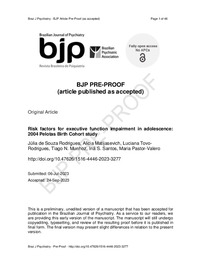Título :
Risk factors for executive function impairment in adolescence: 2004 Pelotas Birth Cohort study |
Autor :
Rodrigues de Souza, Júlia Janine 
Matijasevich, Alicia 
Tovo-Rodrigues, Luciana 
Munhoz, Tiago N
Santos, Iná 
Pastor-Valero, Maria  |
Editor :
Brazilian Psychiatric Association |
Departamento:
Departamentos de la UMH::Salud Pública, Historia de la Ciencia y Ginecología |
Fecha de publicación:
2023-11 |
URI :
https://hdl.handle.net/11000/30535 |
Resumen :
Objective: To investigate risk factors associated with impaired attention-related executive functions (EFs) at age 11 and working memory at age 15.
Methods: Data from the population-based 2004 Pelotas Birth Cohort was analyzed at ages 11 (N=3,582) and 15 (N=1,950). The study measured attentional control, cognitive flexibility, and selective attention using the Daily Attention Test for Children. Spatial working memory was assessed by the Cambridge Automated Neuropsychological Test Battery. Logistic regression was employed to explore the relationship between perinatal and childhood exposures and EF impairment.
Results: Low maternal education had a significant negative impact on EFs. At age 11, it was associated with decreased attentional control (OR=3.04; CI95% 2.09-4.43), and at age 15, it was linked to impaired spatial working memory (OR=2.21; CI95% 1.58-3.09). Additional risk factors included low family income, black or brown maternal skin color, high parity, prematurity, low birth weight, and a high number of siblings. Breastfeeding, regardless of duration, was found to be a protective factor against impaired cognitive flexibility (OR=0.38; CI95% 0.22-0.65).
Conclusion: This study underscores the lasting impact of perinatal exposures on EFs development. Policies that mitigate the negative effects of risk factors and promote EF development, especially among vulnerable populations, are needed.
|
Palabras clave/Materias:
Birth cohort
adolescent
attention
memory |
Área de conocimiento :
CDU: Ciencias aplicadas: Medicina |
Tipo de documento :
info:eu-repo/semantics/article |
Derechos de acceso:
info:eu-repo/semantics/openAccess
Attribution-NonCommercial-NoDerivatives 4.0 Internacional |
DOI :
https://doi.org/10.47626/1516-4446-2023-3277 |
Publicado en:
Braz J Psychiatry 2023 Nov 23 |
Aparece en las colecciones:
Artículos Salud Pública, Historia de la Ciencia y Ginecología
|
 La licencia se describe como: Atribución-NonComercial-NoDerivada 4.0 Internacional.
La licencia se describe como: Atribución-NonComercial-NoDerivada 4.0 Internacional.
.png)
